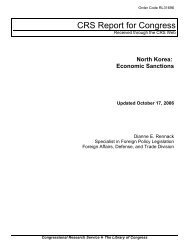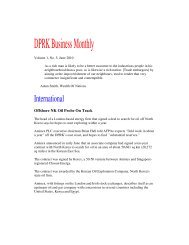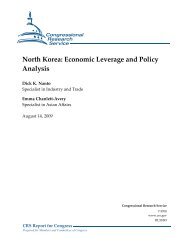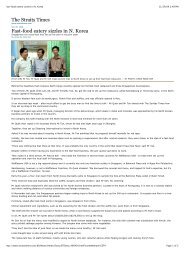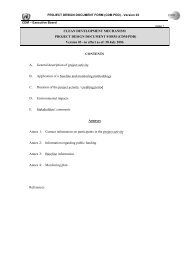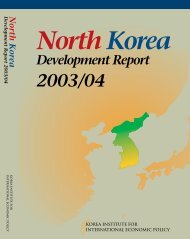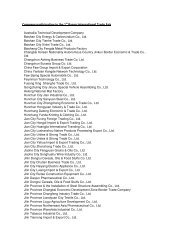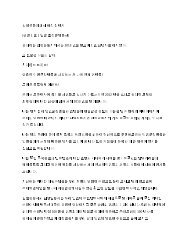North Korean Policy Elites - Defense Technical Information Center
North Korean Policy Elites - Defense Technical Information Center
North Korean Policy Elites - Defense Technical Information Center
You also want an ePaper? Increase the reach of your titles
YUMPU automatically turns print PDFs into web optimized ePapers that Google loves.
speak of divisions instead of groups, fault lines instead of fissures. Research can suggest where<br />
the fault lines lie, but it is far more difficult to know who belongs to which division, what they<br />
know and how they know it, what they think though dare not say, and how they might react to a<br />
particular emergent situation. Nonetheless, behind each fault line are a number of <strong>North</strong> <strong>Korean</strong><br />
elites, and certain messages, if received, are bound to appeal to them.<br />
There are a number of fault lines to analyze: the so-called “lesser” versus “greater”<br />
branches of the Kim family, Kim Il-sung confidants versus Kim Jong-il confidants, the <strong>Korean</strong><br />
Workers’ Party versus the <strong>Korean</strong> Peoples’ Army, soldiers versus generals, army versus local<br />
people, the First Security Department versus the Second, and no doubt more. Recently gaining<br />
some attention in the press is a potential fault line within the Kim family that may underlie the<br />
succession to Kim Jong-il. Will Kim appoint his eldest son, Kim Jong-nam, born of Sung Haerim?<br />
Or will he name the younger Kim Jong-chul, or the younger yet Kim Jong-woon, both born<br />
of Ko Yong-hee? 15 This is an important matter and we should analyze all available information.<br />
However, it is hard to glean more than anecdotes and harder still to know how to affect the<br />
outcome.<br />
However, there may be some fault lines and divisions more susceptible to analysis and<br />
outside influence. <strong>North</strong> Korea is benighted and desperately poor. That means that among the<br />
most important determinants of power are information and money, both commodities that are to<br />
a significant extent derived outside <strong>North</strong> Korea. The elites that derive these benefits have some<br />
window on the outside world, making them more accessible to us. We should examine <strong>North</strong><br />
<strong>Korean</strong> elites and some of their avenues to outside information and money.<br />
D. THE ELITE IN GENERAL<br />
Bearing in mind the qualifications just outlined, it is reasonable to say that <strong>North</strong> Korea<br />
has an elite, centered in Pyongyang. Among this elite, architects of South Korea’s “sunshine<br />
policy” such as former president Kim Dae-jung and his reunification aide Lim Dong-wan purport<br />
to see traditionalists and reformers, hawks and doves. Some western observers agree. 16 Frankly,<br />
their case is overstated.<br />
Oh and Hassig point out that, “most likely the elite population, as well as the masses,<br />
rarely engages in political thought, thereby avoiding the discomfort of cognitive<br />
15 Fairclough, Gordon, “Pyongyang Place: The Family Saga of Kim Jong Il,” The Wall Street Journal, p. A1,<br />
October 10, 2003; “Japanese Weekly Examines Reports that ‘Big Change to Occur Soon in <strong>North</strong> Korea’,”<br />
Tokyo AERA in Japanese, p. 76-77, October 6, 2003, FBIS translation JPP20030930000154.<br />
16 Harrison, Selig, “<strong>North</strong> <strong>Korean</strong> ‘Good Guys’ require U.S. Assistance,” USA Today, p. 13A, January 7, 2004.<br />
V-5



